Learn how to grow elderberries for food and herbal support, right in your own backyard! Elderberries can be grown from cuttings, starts, or seeds. Growing elderberries is easy!
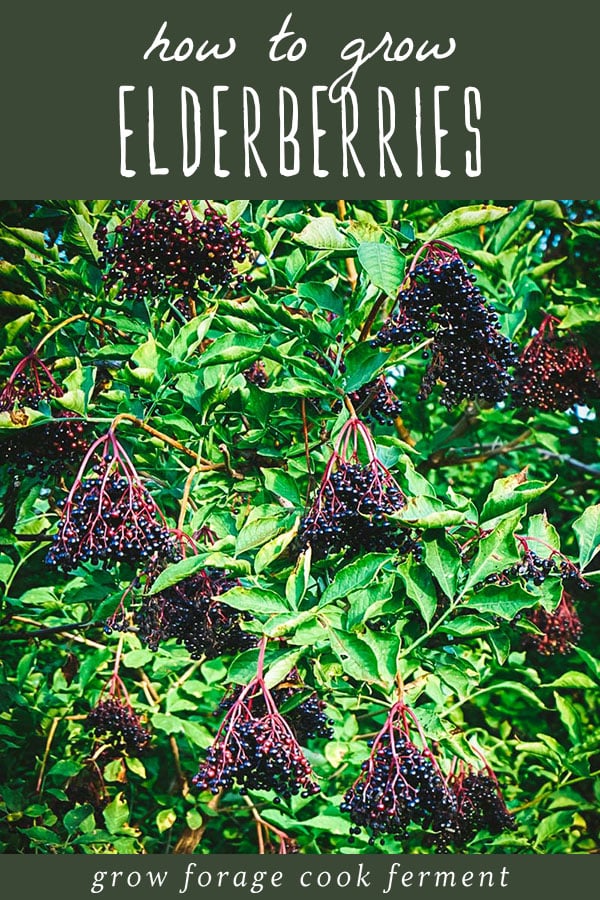
Want to save this post for later?
Why Grow Your Own Elderberry Shrubs?
Elderberries have gained significant popularity in recent years due to their potent herbal properties. Because of this popularity, herbal shops and online retailers often sell out by the time fall gets underway.
This is frustrating for those of us who want to make our own elderberry syrup or elderberry tincture for cold and flu season. The good news is that growing elderberries in your backyard is really easy!
Since acquiring dried elderberries can sometimes be very difficult, especially during cold and flu season, I prefer to either forage or grow my own whenever possible.
Foraging for wild elderberries is one way to obtain them, but not everyone has the time, desire, or ability to do that. Now that I have a toddler around I know that getting out to forage can sometimes be impossible, so we decided to grow our own elderberries!
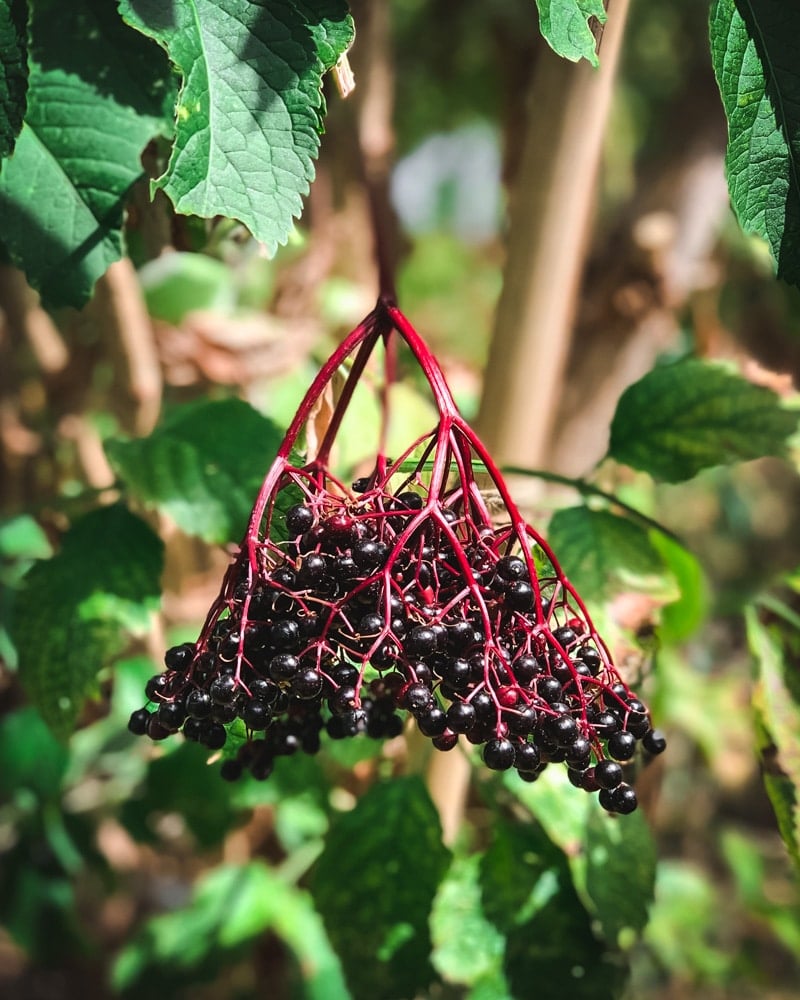
Elderberry Benefits for the Garden, Home, & Apothecary
Elderberries have long been known as very beneficial plants to have growing in your garden. They are an excellent choice for a permaculture forest garden plant. The flowers, berries, leaves, stems, and branches all have uses in the home, kitchen, herbal apothecary, or garden.
In traditional herbalism, elderflower is a longstanding and popular ingredient in skin care products, such as creams and salves. They are well-known among herbalists for their calming properties, especially for itchy or irritated skin.
The flowers can be distilled into elderflower water, an astringent used in making eye and skin lotions. Or, infused into an oil to make a salve, lotion, or cream.
Elderflowers can also be eaten raw or fried. See my post on elderflower recipes for more ideas!
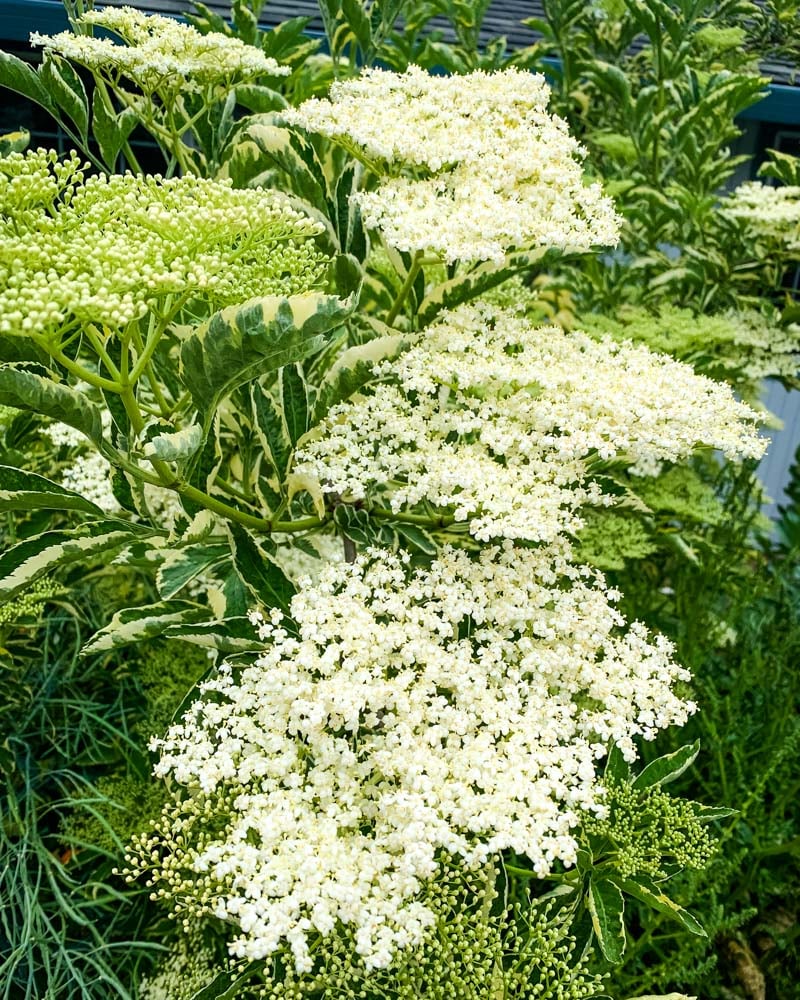
Use the berries for making wine, jam, preserves, dye, and syrups for herbal support. Here are some great elderberry recipes to get you started!
Elderberries have numerous uses in traditional herbalism due to their potential immune-boosting benefits. Herbalists often use dried or fresh berries to make elderberry syrup.
Elder leaves are toxic if ingested in large amounts. However, herbalists sometimes use them externally in salves or as a poultice to soothe occasional swelling.
The leaves can also be rubbed on the skin and may help to repel insects, or made into a liquid by decoction and sprayed on plants as an insecticide and antifungal agent.
The stems of elder branches can be hollowed out to make flutes and blow pipes, and the mature wood is excellent for woodworking.
The entire plant can be added to a compost pile, as it speeds decomposition and improves fermentation.
When developing a property, elder bushes can be used as a pioneer species, companion plant, hedge, or a windbreak. The dense foliage is also good forage and nesting habitat for many kinds of birds.
Elderberry Varieties
There are two main varieties of elderberry that are best for growing:
Black elderberry (Sambucus nigra), which is native to Europe, but has naturalized in much of Asia and North America. Another very similar species of black elderberry is the American Elderberry (Sambucus canadensis), which is native to eastern North America.
Blue Elderberry (Sambucus nigra ssp. cerulea), which is native to western North America.
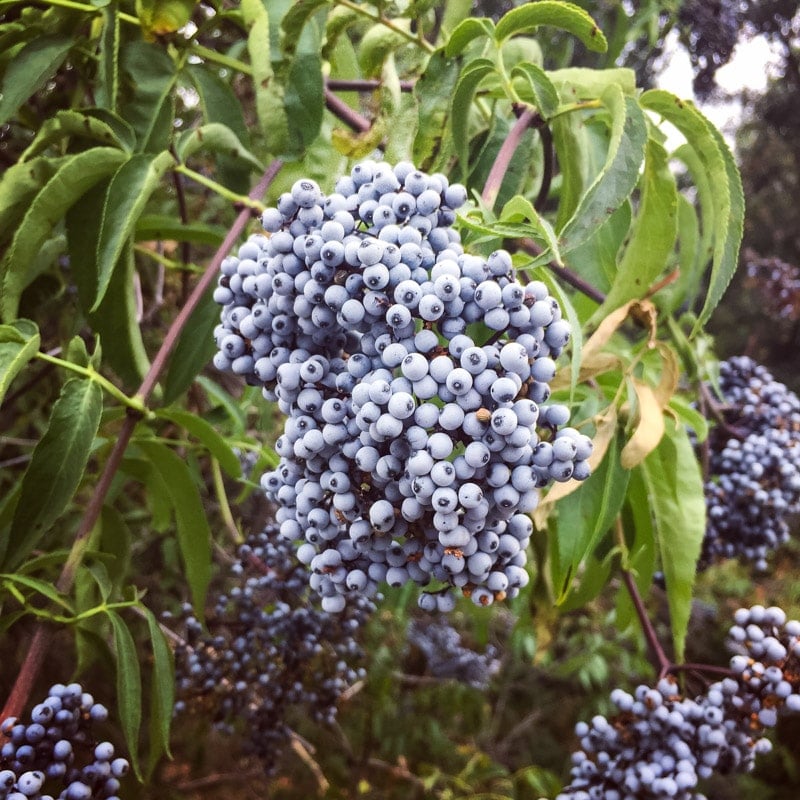
When searching nurseries and online plant stores for elderberry varieties, you will also find many ornamental types such as Black Lace and Variegated. They are all different subspecies of Sambucus nigra.
As far as I’ve seen, most of these species still have edible berries, but I’m not sure if they have the same herbal benefits (my guess is that they probably do, being that they are subspecies to the medicinal type Sambucus nigra).
There is also red elderberry (Sambucus racemosa), that is native to the Pacific Northwest. Their berries are toxic when raw and they must be cooked prior to eating.
Just take note that all elderberry varieties contain some amount of toxicity raw, and when eaten can range from unpleasant tasting to stomach upsetting for some people. Others will have no problems and love the taste. Any toxins will be eliminated when cooked.
How to Grow Elderberries
Elderberry bushes are extremely easy to grow and care for, thriving in full sun or partial shade.
Depending on variety and conditions, they can grow from 10’ to 20’ tall, but can be pruned and kept much smaller. They do best in gardening zones 3-8.
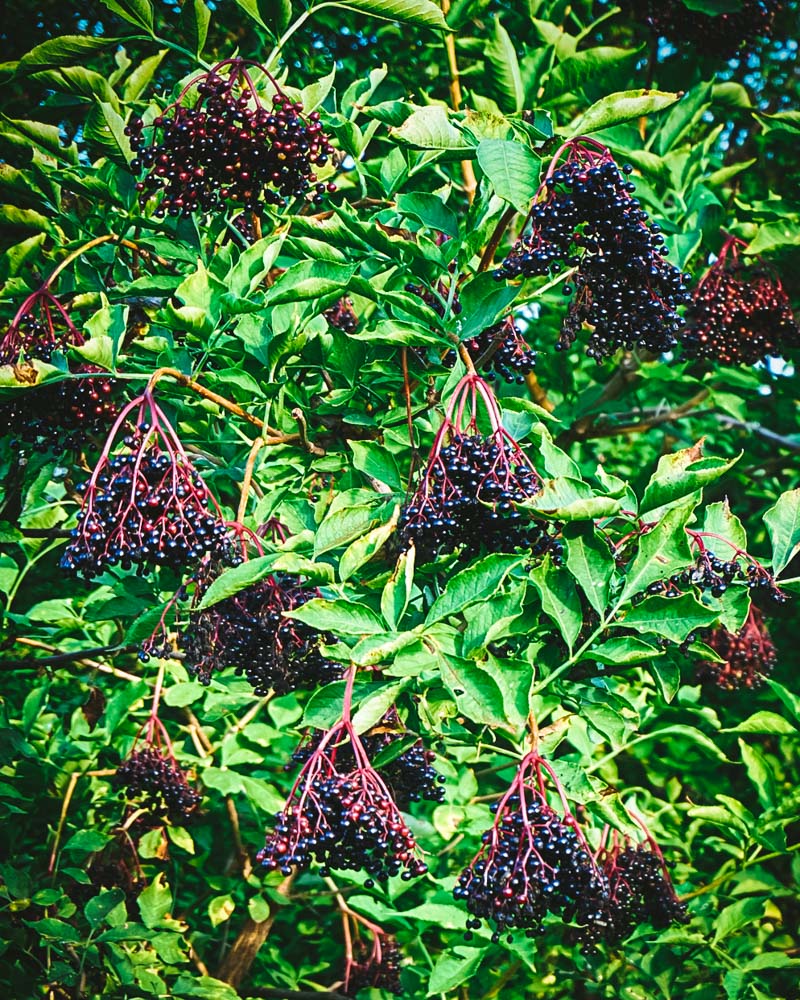
Elderberries prefer rich, moist soil that is well drained, but can tolerate many different growing conditions. They are disliked by deer and pests, and do not suffer from any diseases.
Elders are very prolific and can begin producing fruit the first year they are planted. Every year they will sprout new canes. After several years, older canes will produce less fruit and can be pruned back in the winter if desired.
Elders are partially self fertile, but will produce more berries with another variety planted nearby.
How to Propagate Elderberries from Cuttings
Elderberry bushes are very easy to propagate from cuttings, and you can often just cut some pieces off a growing tree and push them in the ground and they will grow.
Suckers from a mature plant can also be dug up and replanted elsewhere.
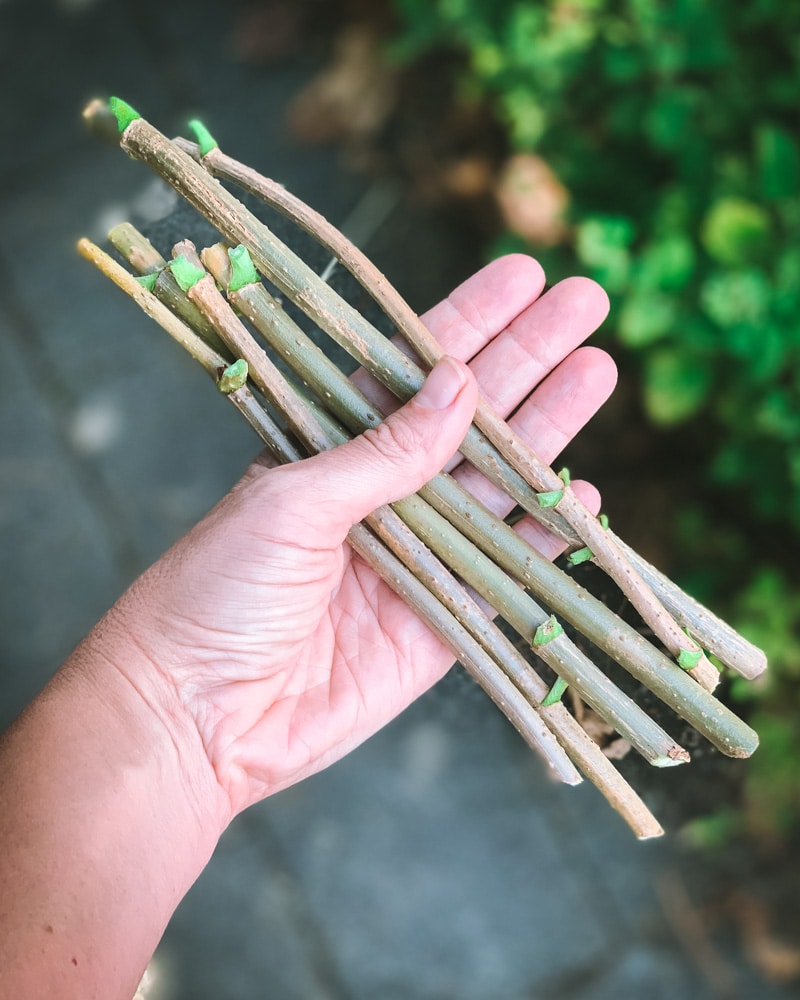
A more sure fire way to propagate is in late fall through early spring, when the plant is dormant. Select a branch from an elder bush you wish to grow and cut it into six inch pieces.
Remove the leaves, keeping the nodes intact, and stick them a pot of sand mixed with peat moss or potting soil.
Soaking the cuttings in a natural willow bark rooting hormone first can help the process, but isn’t totally necessary as elderberry will readily root on its own.
Keep the pot moist and in sunlight. Roots should grow in a couple months, and then they can be planted out. If you live in a cold climate wait until spring to plant the cuttings.
If you don’t have access to elderberry shrubs to take cuttings from, you can order them from Norm’s Farm or here on Amazon.
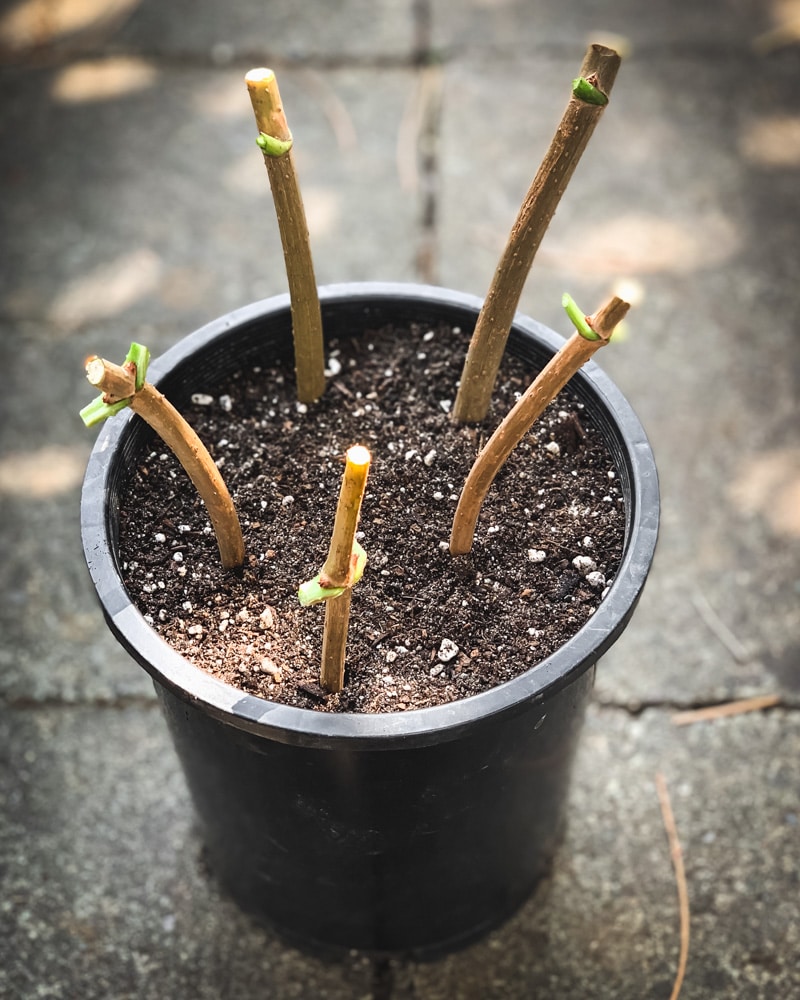
Where to Get Elderberry Starts and Seeds
If you don’t want to grow elderberries from cuttings, you can also purchase them as starts. These tend to come in gallon or half gallon size pots. They can also be grown from seed.
Raintree Nursery has a good selection of different elderberry variety starts.
Strictly Medicinal Seeds has a nice selection of both live plants and seeds.
You can also try your local nursery, many are starting to carry elderberry now!
Elderberries are so easy to grow and require very little maintenance; there’s no reason not to grow your own herbal support!

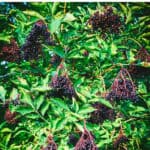


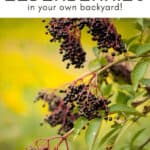
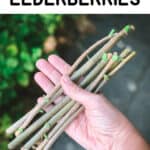


I live in zone 5. Should I cover my Elderberry with straw before snow? It is only a small bush.
If it’s in the ground, it should be fine in zone 5 without any straw.
I would love to grow elderberry but I live in Alabama and have clay soil. How can I plant to overcome the well draining soil? I need help.
Hi there. Adding mulch to your soil could help hold onto the water in the soil.
Seems the birds always win when our wild berries ripen near our house. Bushes are about 10 feet tall.
I have a question, how long can you keep an elderberry in containers? I am in a zone 5 so I would have to keep it in the basement in winter. I don’t think it would survive the winter out side here. Happy Holidays how ever or where ever you are.
Wishing you all peace and love :-)
Hi Shelagh, I live in zone 5 as well and elderberry does well here! They are hardy to zones 3 or 4. I would leave it outside as I don’t think keeping it in a basement would be good for the plant.
I am having a very hard time with elderberry. The deer have eaten them to the ground in years past, they are fenced now, but the deer still reach over to eat the tender spring branches. And the last 2 years they have been over run with sawfly larvea/ caterpillars. This is their 4th year in the ground and I have one bush with flowers for the first time since I rooted them :-( fingers crossed for berries!
What have you done to try to deter deer. The zest soap? Fencing? Plant any other deterring plants nearby? Anything?
Some of the things I have tried have worked for my yard but I don’t have any elders. I have apples, grapes, goose berries and black current
One was get some plastic containers with good lids poke some holes just below the top. Then add water to about 2-3 inches below the holes add a couple of moth balls. Each container will protect 8 square feet.
Another is plant things the deer don’t like horehound which is good for making cough syrup and bleeding hearts, I don’t what they don’t like about the flowers but they work. Good luck with next years harvest.
These pictures look like a plant that sprang up on my property this past summer! Could they have been deposited in my yard by birds? The plants were in two different locations in my yard and I thought they were good for birds and nothing else, but if they’re Elderberries, that’s another story! I will have to wait and see if they come back in the Spring and then do some research. Great article!
Yes, elderberries are a common shrub species found in fencerows across America. As children, my parents would drive us around the nearby countryside, stopping to forage on the fence lines for our neighbors’ farm fields. It rarely too more than a couple hours to collect enough grocery bags of elderberries for my mother to make several batches of her very favorite jelly.
Hi , Jesse here Muilty Rare friut grower
I have a blacklace elderberry it’s 1 year old. Had some nice flowers, What i’d like to know can the black lace- Black beauty- Instant karma are compatibe to pollinate. But, can this series of elderberries also be pollinated by the older more traditional types? Have about 8 different types. Sometimes nurseries/ business don’t mention all the pollinators so they can sell more of the new plants. when someone has
what it takes at home already.
If someone knows for sure comment please. Thank You’s For Your Time. Jesse
In general, you should try to stay away from hair treatments and products that include chemicals like parabens, DEA and sulfates.
Wild elderberries in my area produce large quantities of fruit and that is the only variety around.
Japanese beetles love my elderberries
Same here! And the birds eat my berries!!! :(
Try using fruit bags!
I have many cuttings but put them I water. They are starting to grow roots, when should I transplant to soil? Thanks!
When the roots are 2 inches long, they’re ready to be potted.
When is best time to plant elderberry seeds?
Fall is the best time.
Have I missed the window if I plant now?
Hi Mary. As long as you plant them in a pot, they should be ready to go into the ground come spring.
Hi, I have a blue Elderberry in my garden, great flowers but then no berries! any ideas?
I’m sorry, I don’t know why that is. Are you sure it’s blue elderberry?
Yes, the blue elderberry is a native variety in North America.
I also have 1 yr. old bushes. beautiful flowers yet only 6 berries!
Perhaps berries appear after flowers have been pollinated by insects?
Where I live there are other plants that looks like elderberry. How can I be sure I’m getting the right one
Hi, Beverly. There are many resources online or in books for properly identifying elderberry, including my post on foraging for elderberries!
If you live in a cold climate and take cuttings in the fall and put them in a pot, should you bring it inside over the winter? Or is it ok to leave outside?
They want to stay at around 40 degrees until springtime, so you may want to put them somewhere it stays cool. You don’t want them to get too warm or else they will think it’s spring and will start to leaf out. The alternative is to wait until late winter or early spring to take cuttings.
I am planning on planting 2 elderberry bushes (Black Lace & Instant Karma) in my backyard but as foundation plantings within a few feet of each other to cross pollinate in zone 5, SW exposure. Will they need to more room or will 3 – 4 feet from the house be enough room for them (and the house)?
Do bears eat the fruit? We have land we plan on building on in North Georgia (zone 7/8). I want to plant these SO BAD – but i don’t want to attract more bears! Help?!
The bears in our area do eat them all of them. I’m in upstate N.Y.and a friend of mine lost her entire crop to a naughty bear this year. The bear was very very thin a young male who is on his own now mom tossed him out. He may have eaten them out of desperation because she has never had an issue before.
I just received some cuttings, a couple have a root. The others have nodules on them. I’m in zone 6. Frost is gone. Can I plant them out now?
Tammy, you can plant these right after cutting and they will grow! I cut mine back in January when we had a warm (er) spell and just stuck them in a bucket of soil. They started sprouting leaves when it warmed up a bit and I ended up selling them for $10 each at our garden group. You should probably cut them back at the end of the season and either discard the cuttings or make some money starting your own plants. Good luck!
Mine are not purple / black. They are green / white, they remain green. Mature to green. Can I eat these……syrup? I planted these, and so disappointed that they are not the darker version.
If they never ripen to dark blue, black, or red, they aren’t elderberries.
Native elderberries growing wild here with berries for birds and harvest. Central Arkansas.
Hi, elderberries are not deer resistant. I have a bush of black elderberry I’ve been trying to grow for 3 years; the deer keep eating one side. Next Spring I think I’ll drape a net over it – what do you think, a bird net that they use for strawberries? – and hopefully it will be given a chance. I’m only there one week a month April through October so I can’t spray and have it last. If anyone has any other deer tips I’m open to hearing them! (White tail, Illinois)
Deer hate garlic. Plant some garlic around your bush. And it’s gross but they also hate human hair because it smells like humans obviously. You can take the hair out of the drain after your shower and put it around your bush to help deter them
Or go to a salon or barber and get what they sweep up every night. Best place I have found for acquiring hair for deterrent.
Hi There
Sorry about your troubles with the deer. I live in southern Illinois have the same problem. I buy a cheap roll of tulle from the fabric store and fasten it over the bush. They can’t eat through that neither can birds but the bush can breathe and get sun. Hope this helps! Happy growing 😉
Nowhere in this article that I see cross pollination mentioned. You really need two different types of elderberry bushes to cross pollinate each other to get a prolific harvest and healthier plants. I ordered mine from stark brothers and they are doing phenomenally well
Hi Jen, I actually say this in the article: “Elders are partially self fertile, but will produce more berries with another variety planted nearby.”
When you say different varieties, you mean like a black elderberry(European) with an American Elderberry?
I have now 4 plants in my yard, all native Elderberry, but from different nurseries. Does that mean I won’t get any berries?
Thank you
I have 3 American Elderberries in their 3rd year in northwest WI. They produced many berries in the 2nd year and a huge bounty now in the 3rd–even after harvesting many flowers for Elderflower Liqueur.
Absolutely no problem with pollination!
I live in Israel in the Jordan Valley. it is low altitude, zone 11. I have one shrub which flowers and I wanted to make syrup but the flowers are not fragrant. is there a nutrient to promote sweet smelling blossoms?
I only have one bush and it is full of berries every summer.
Should first year starters be covered come winter? In Manitoba, Canada, zone 3.
These clumps of elderberries look very similar to the wild cherry tree we have.Not sure if they’re related.
I’ve purchased North American, bare root plants from the Arbor Day Foundation.
2 of my Elder plants are from Arbor Day Foundation. They never informed me that I need different varieties to get berries. Im doing it for the birds. The plants are beautiful and have taken off, but it bothers me that they don’t educate someone about the plant.
I have as well, that’s where I got my originals and they were truly prolific. It is now early June and the bushes are over 7 feet tall. Good luck!
Can starter plants be planted in northern US in fall or do we need to wait until Spring?
I live in Zone 6. Bought bare roots from Arbor Day Foundation. They sent for fall planting at Thanksgiving!
Can I propagate blackberries in this same manner?
My elderberries have little white worms in them, is it game over for them or is there a way to deal with them like with broccoli?
an organic pesticide containing Spinosad along with vinegar traps as a means for control.
Buy a couple of habanero chili and a head if garlic, take the stem from chili and peel the garlic, put un blender with water, blen for a couple of minutes with water, strain the liquid, discard the pulp, keep in a half gallon container fill with water and use this to spray your plants, the worms or.other insects won’t like the taste and die or leave the plants alone.